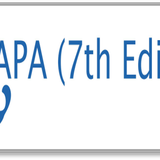Family Business Control, Strategy Selection And Strategic Performance Measurement Usage
DOI:
https://doi.org/10.24912/ja.v25i1.729Abstract
Firms that are managed by family businesses have developed and have an impact on the growth of a country's economy. The family business has been a concern in much of the research literature. The development of family businesses also has an interesting phenomenon related to business governance systems, especially in management control systems. Therefore, this study aims to examine the effect of the owner's role in the management of the family business, and the strategy selection on to use of strategic performance measurement on the family business. The research was conducted using quantitative methods primary data through a survey of micro, small and medium entrepreneurs in the city of Palembang. A total of 150 questionnaires were distributed to entrepreneurs. The number of questionnaires used in this study was 107 (71%). ANOVA analysis was used to test the hypothesis. The results showed that the role of the owner in controlling the family business and the strategy selection affected the strategic performance measurement.
References
Afriany, A. N., Budiarto, D. S., and Putri, A. N. A. (2019). Hubungan antara kepemilikan keluarga dengan kesuksesan bisnis pada usaha kecil & Menengah (UKM). Akuntansi Dewantara, 3(1), 67 – 74.
Aghajari, N., and Senin, A. A. (2013). Strategic orientation and dual innovative operation strategies: Implications for performance of manufacturing SMEs. Asia-Pacific Journal of Business Administration, 6(2), 127 – 147.
Basco, R. (2014). Exploring the influence of the family upon firm performance: does strategic behavior matter? International Small Business Journal, 32(8), 967 – 995.
Basco, R., and Calobro, A. (2016). Open innovation search strategies in family and non-family SMEs. Academia Revista Latinoamericana de Administración, 29(3), 279 – 302.
Basco, R., and Pérez Rodríguez, M. . (2011). Ideal types of family business management: Horizontal fit between family and business decisions and the relationship with family business performance. Journal of Family Business Strategy, 2(3), 151 – 165.
Brundin, E., Samuelsson, E. ., and Melin, L. (2014). Family ownership logic: framing the core characteristics of family businesses. Journal of Management & Organization, 2(1), 6–37.
Carney, M., Gedajlovic, E. ., Heugens, P. ., Van Essen, M., and Oosterhout, J. . (2011). Business group affiliation, performance, context, and strategy: A meta-analysis. Academy of Management Journal, 54(3), 437–460.
Chen, Z., and Tan, K. H. (2013). The impact of organization ownership structure on JIT implementation and production operations performance. International Journal of Operations & Production Management, 33(9), 1202 – 1229.
Cheng, M., Lin, B., and Wei, M. (2015). Executive compensation in family firms: the effect of multiple family members. Journal of Corporate Finance, 32(1), 238–257.
Cinquini, L., and Tennuci, A. (2010). Strategic management accounting and business strategy: A loose coupling? Journal of Accounting & Organizational Change, 6(2), 228 – 259.
Diéguez-Soto, J., Manzaneque, M., Gonzalez-García, V., and Galache-Laza, T. (2019). A study of the moderating influence of R&D intensity on the family management-firm performance relationship: Evidence from Spanish private manufacturing firms. BRQ Business Research Quarterly, 22(2), 105–118.
Fairclough, S., and Micelotta, E. . (2013). Beyond the family firm: reasserting the influence of the family institutional logic across organisations (Boxenbaum,). Institutional Logics in Action, Emerald Group Publishing.
Franco-Santos, M., Lucianetti, L., and Bourne, M. (2012). Contemporary performance measurement systems: A review of their consequences and a framework for research. Management Accounting Research, 23(2), 79–119.
Gimbert, X., Bisbe, J., and Mendoza, X. (2010). The Role of Performance Measurement Systems in Strategy Formulation Processes. Long Range Planning, 43, 477 – 497.
Heinicke, A. (2018). Performance measurement systems in small and medium-sized enterprises and family firms: a systematic literature review. Journal of Management Control, 28(4), 457 – 502.
Helsen, Z., Lybaert, N., Steijvers, T., Orens, R., and Dekker, J. (2016). Management control system in family firms: A review of the literature and directions for future. Journal of Economic Surveys, 31(2), 410 – 435.
Ho, J. L. Y., Wu, A., and Wu, S. Y. C. (2014). Performance measure, consensus on strategy implementation and performance: Evidence from the operational-level of organizations. Accounting Organizations and Society, 39(1), 38 – 58.
Hofstede, G. (2011). Dimensionalizing cultures: The hofstede model in context. Online Readings in Psychology Dan Culture, 2(1), Article 8.
Hoque, Z. (2014). 20 Years of Studies on the Balanced Scorecard: Trends, Accomplishments, Gaps and Opportunities for Future Research. The British Accounting Review, 46, 33–59.
Kadir, N. (2014). The influences of the performance of the owner’s business and personality-based Small dan medium enterprises: A study on SME’s in Sengkang regency. Journal of Business and Management, 16(4), 21 – 24.
Kallmuenzer, A., Hora, W., and Peters, M. (2018). Strategic decision-making in family firms: An explorative study. European Journal of International Management, 12(5–6), 655 – 675.
Kaplan, R. ., and Norton, D. (2006). Alignment; Using the Balanced Scorecard to Create Corporate Synergies. Harvard Business School Press.
Kober, R., Ng, J., and Paul, B. J. (2007). The interrelationship between management control mechanisms and strategy. Management Accounting Research, 18(4), 425 – 452.
Kotey, B., and Meredith, G. G. (1997). Relationships among owner/manager personal values, business strategies, and enterprise performance. Journal of Small Business Management, 35(2), 37 – 61.
Kraus, K., and Lind, J. (2010). The impact of the corporate balanced scorecard on corporate control—A research note. Management Accounting Research, 21, 265 – 277.
Laakkonen, A., and Kansikas, J. (2011). Evolutionary selection and variation in family businesses. Management Research Review, 34(9), 980–995.
Miller, D., Amore, M. ., Le Breton-Miller, I., Minichilli, A., and Quarato, F. (2018). Strategic distinctiveness in family firms: firm institutional heterogeneity and configurational multidimensionality. Journal of Family Business Strategy, 9(1), 16 – 26.
Munoz-Bullon, F., Sanchez-Bueno, M. J., and Suarez-Gonzalez, I. (2018). Diversification decisions among family firms: the role of family involvement and generational change. BRQ Business Research Quarterly, 21(1), 39 – 52.
Mustakallio, M., Autio, E., and Zahra, S. A. (2002). Relational and contractual governance in family firms: Effects on strategic decision making. Family Business Review, 15(3), 205 – 222.
Pham, T. ., Bell, R., and Newton, D. (2019). The father’s role in supporting the son’s business knowledge development process in Vietnamese family businesses. Journal of Entrepreneurship in Emerging Economies, 11(2), 258 – 276.
Punniyamoorthy, M. R., and Murali, R. (2008). Balanced score for the balanced scorecard: A benchmarking tool. Benchmarking: An International Journal, 15(4), 420 – 443.
Quinn, M., Hiebl, M. R. W., Moores, K., and Craig, J. B. (2018). Future research on management accounting and control in family firms: suggestions linked to architecture, governance, entrepreneurship and stewardship. Journal of Management Control, 28(4), 529 – 546.
Ramayah, T., Samat, N., and Lo, M. C. (2011). Market orientation, service quality and organizational performance in service organizations in Malaysia. Asia-Pacific Journal of Business Administration, 3(1), 8–27.
Raval, S. J., Kant, R., and R, S. (2019). Benchmarking the Lean Six Sigma performance measures: A balanced score card approach. Benchmarking: An International Journal, 26(6), 1921–1947.
Ray, S., Mondal, A., and Ramachandran, K. (2018). How does family involvement affect a firm’s internationalization? An investigation of Indian family firms. Global Strategy Journal, 8(1), 73 – 105.
Remiasa, M., and Wijaya, S. A. (2014). Analsis proses suksesi perusahaan keluarga studi pada PT Putraasean. Kinerja, 18(2), 141 – 156.
Sacristán-Navarro, M., Gómez-Ansón, S., and Cabeza-García, L. (2011). Family ownership and control, the presence of other large shareholders, and firm performance: further evidence. Family Business Review, 24(1), 71–93.
Sbarba, A. D., and Marelli, A. (2018). Family-controlled businesses and management control: the framing of “shareholder-oriented” practices. Journal of Management Control, 28(4), 417 – 456.
Senftlechner, D., and Hiebl, M. (2015). Management accounting and management control in family businesses: Past accomplishments and future opportunities. Journal of Accounting & Organizational Change, 11(4), 573 – 606.
Shahzad, F., Rehman, I., and Nawaz, F. (2019). Financial reporting quality, family ownership, and investment efficiency: An empirical investigation. Managerial Finance, 45(4), 513 – 535.
Songini, L., Gnan, L., and Malmi, T. (2013). The role and impact of accounting in family business. Journal of Family Business Strategy, 4(2), 71 – 83.
Speckbacher, G., and Wentges. (2012). The impact of family control on the use of performance measures in strategic target setting and incentive compensation: A research note. Management Accounting Research, 23, 34 – 46.
Suud, D. (2020). Lebih 163 Ribu UMKM Tumbuh di Sumsel, Paling Banyak di Palembang. https://indonesiainside.id/ekonomi/2020/02/20/lebih-163-ribu-umkm-tumbuh-di-sumsel-paling-banyak-di-palembang
Teeratansirikool, L., Siengthai, S., Badir, Y., and Charoenngam, C. (2013). Competitive strategies and firms performance: The mediating role of performance measurement. International Journal of Productvity and Performance Management, 62(2), 168 – 184.
Tsao, S. M., Chang, Y. W., and Koh, K. (2017). Founding family ownership and myopic R&D investment behavior. Journal of Accounting, Auditing & Finance, 34(3), 361 – 384.
Turner, M. J., and Guilding, C. (2010). Hotel management contracts and deficiencies in owner-operator capital expenditure goal congruency. Journal of Hospitality Dan Tourism Research, 34(4), 168 – 184.
Downloads
Published
How to Cite
Issue
Section
License
Copyright (c) 2021 Jurnal Akuntansi

This work is licensed under a Creative Commons Attribution-NonCommercial-ShareAlike 4.0 International License.
This journal provides immediate open access to its content on the principle that making research freely available to the public supports a greater global exchange of knowledge.

This work is licensed under a Creative Commons Attribution-NonCommercial-ShareAlike 4.0 International License



















